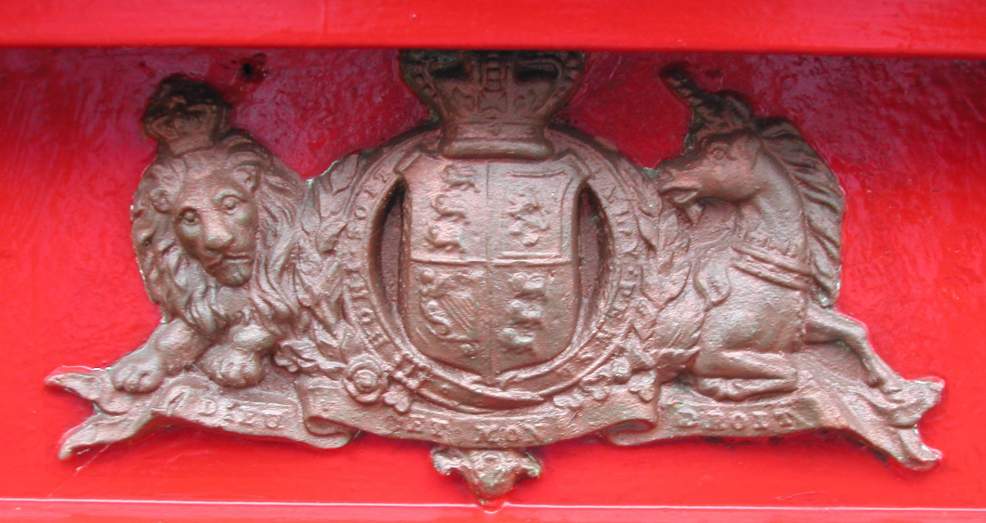|
A short introduction to the history of the British Pillar Box
.
2003 year saw the 150th anniversary of mainland Post Boxes in the UK; they were first introduced in the Channel Islands in 1852, with Botchergate in Carlisle becoming the first mainland location the following year.
The advent of the British wayside letter box can be traced to Sir Rowland Hill, Secretary of the Post Office, and his Surveyor for the Western District, Anthony Trollope, the noted Victorian novelist. Hill sent Trollope to the Channel Islands to ascertain what could be done about the problem of collecting the mails on a pair of islands. It was customary up until that time, to take out going post to the nearest Letter Receiving House or Post Office. Such Houses were usually coaching inns or turnpike houses where the Royal Mail coach would stop to pick up and set down mails and passengers. One took the letter in person to the Receiver or the Postmaster, bought a stamp and handed it over.
Up until 1811, letters were pre-paid by weight and distance, so that the further a letter went, the more it cost to send. That all stopped when Rowland Hill introduced the Uniform Postage (originally set at 4d) that year, enabling the same charge for London to Glasgow as for London to Greenwich. The next big development came, of course, in 1840 with the introduction of a novel device called the adhesive postage stamp. These could be purchased in advance and used to prepay letters at the 1d and 2d rates ( 1/2d stamps came later for postcards), a new-fangled idea that soon caught on.
|
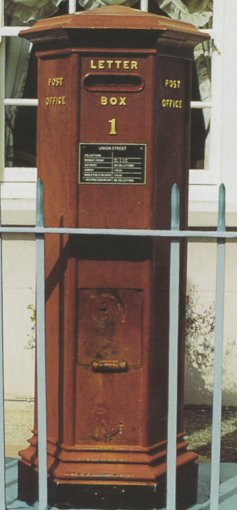
|
Together with the famous Penny Black, the Post Office also introduced pre-paid Postal Stationary, known as Mulready envelopes, from 1st May 1840. This combined the postal charge with a fold-up envelope rather like an air letter of later years.
The problem for the Channel Islands was that not many horse-drawn Royal Mail carriages stopped there! In fact, to post a letter in Jersey or Guernsey, one had to take it down to the quayside and hand it to the Master of the Royal Mail steamer in person; a somewhat inconvenient practice, subject as it was to the ravages of weather and tides.
Trollope subsequently arrived in Jersey in the early Spring of 1852 and proceeded to survey both islands. His recommendation back to Hill was to employ a device he may have seen in use in Paris: a "letter-receiving pillar". It was to be made of cast iron, about four feet high, octagonal in design and painted olive green. Trollope estimated that four would be needed for Guernsey and five for Jersey. The foundry of Vaudin & Son in Jersey was commissioned to produce them and the first was erected in St.Helier in October of 1852.
They were an instant success, despite some obvious problems with rainwater ingress. One Vaudin box still stands in Union Street, St.Peter Port, whilst another is in the National Postal Museum collection (PB1/1).
The very first boxes erected on the mainland are, unfortunately, not recorded, but the designs varied from area to area as each District Surveyor issued their own specifications and tendered to their own chosen foundries. We do know that the first mainland box was erected in Botchergate, Carlisle in 1853. The spot is commemorated today with a replica Penfold box. The earliest surviving mainland designs are the Butt boxes made in Gloucester for the Western Area. These are located at Barnes Cross, near Sherborne in Dorset, inside the former Royal Naval Hospital in Plymouth and in the Haverfordwest town museum. All date from 1853-9. Royal Mail, claim the Barnes Cross box to be the oldest still working in Britain, but this is incorrect. The maker's plate positioned high up on the box show it was from a later batch made in 1859.
|
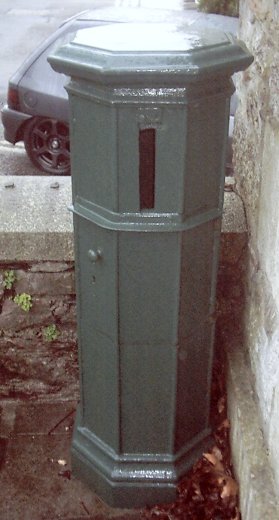 |
The picture at left shows a private version of the first Mainland box (without the VR crest) which can still be found at the Britannia Royal Naval Hospital site in Plymouth. It is no longer in use.
In the Eastern Region, the boxes were founded by Andrew Handyside & Son of Derby, whose handiwork also included the massive roof spans of St.Pancras station and the footbridge at Kings Cross. Three boxes survive, bizarrely two of them in the same town, Framlingham in Suffolk, with a third in the Museum of Lincolnshire Life in Lincoln. Since the only Butt box still in use is one of the later batch from 1859 and the Framlingham boxes are from 1856, they can rightly claim to be the oldest working boxes on the street. These and the Butt boxes are octagonal designs like the Vaudin boxes. In the Midlands area, a large circular fluted design was called for, but the Birmingham foundry of Smith & Hawkes mis-read the specification to produce the Giant Fluted box. Only three were made before the design was altered and these went to London (2) and Birmingham (1) of which one has survived in the BPMA collection. The corrected design is a very attractive box with a vertical aperture, to discourage thieves apparently, and is more widespread. Eleven survive: Birkenhead, Gravesend, Milford on Sea, Mudiford, Eton, Warwick (2), Tottenham, BPMA store and University of the Eastern Cape campus, Durban, South Africa. Many British boxes were exported across the Empire like this. The slightly revised design with a horizontal aperture found its way to Melbourne, Australia (2) as well as Malvern (3 boxes) and Solihull.
|
.
.
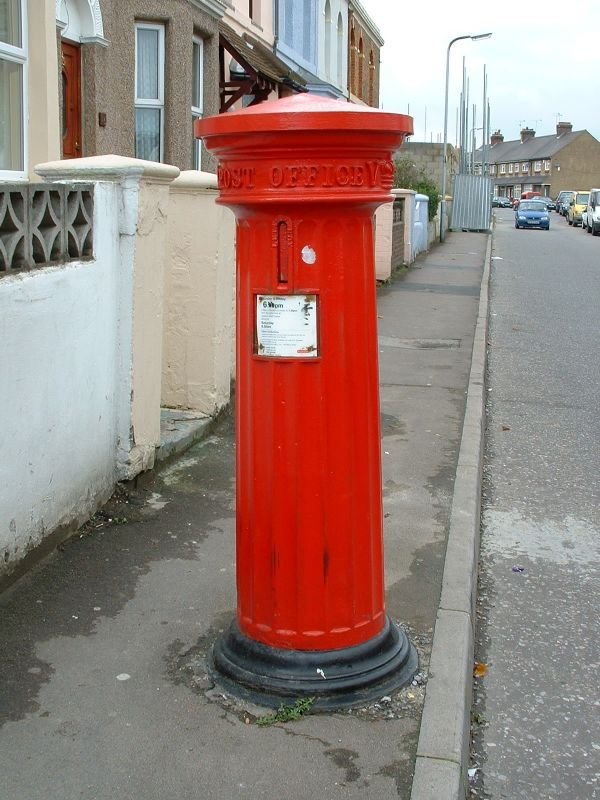
.
Standardisation of sorts came in 1857 with the deliberations of the Committee for Science & Art of the House of Lords. The Committee designed a very ornate box festooned with Grecian style-decoration, but in a major oversight, devoid of any posting aperture! These were hewn out of the cast iron locally, destroying the aesthetic of the box. Fifty were made for London and the big cities and you can see them in Salford Museum and the BPMA store in London. A similar, much simplified version has survived in the attractive green colour of An Post at the Kent railway station in Cork, Eire. Many ex-GPO boxes survive in the Republic, although many have the ciphers ground off or replacement Free State doors. One that survived intact is the National Museum of Ireland's Ashworth box for the Northern District, the sole survivor of this type, on display inside O'Connell St Post Office, Dublin.
.
The first real standard design came in 1861 with the First National Standard box. These were also cast in two sizes for the first time to allow for heavier traffic in big metropolitan areas. A number have survived and they were widely distributed from Brighton to Liverpool, via Stoke, Worthing, London, Havant, Bristol, Congresbury, Goffs Oak and Newport. Similar boxes have also survived in Mauritius.In the busy city of Liverpool, even these boxes could not provide the capacity and security required, so a special design was commissioned from Cochrane Grove & Co of Dudley. Known as Liverpool Specials, three have survived from a batch of six. Two of these are in Liverpool and the other is in the BPMA store.
.
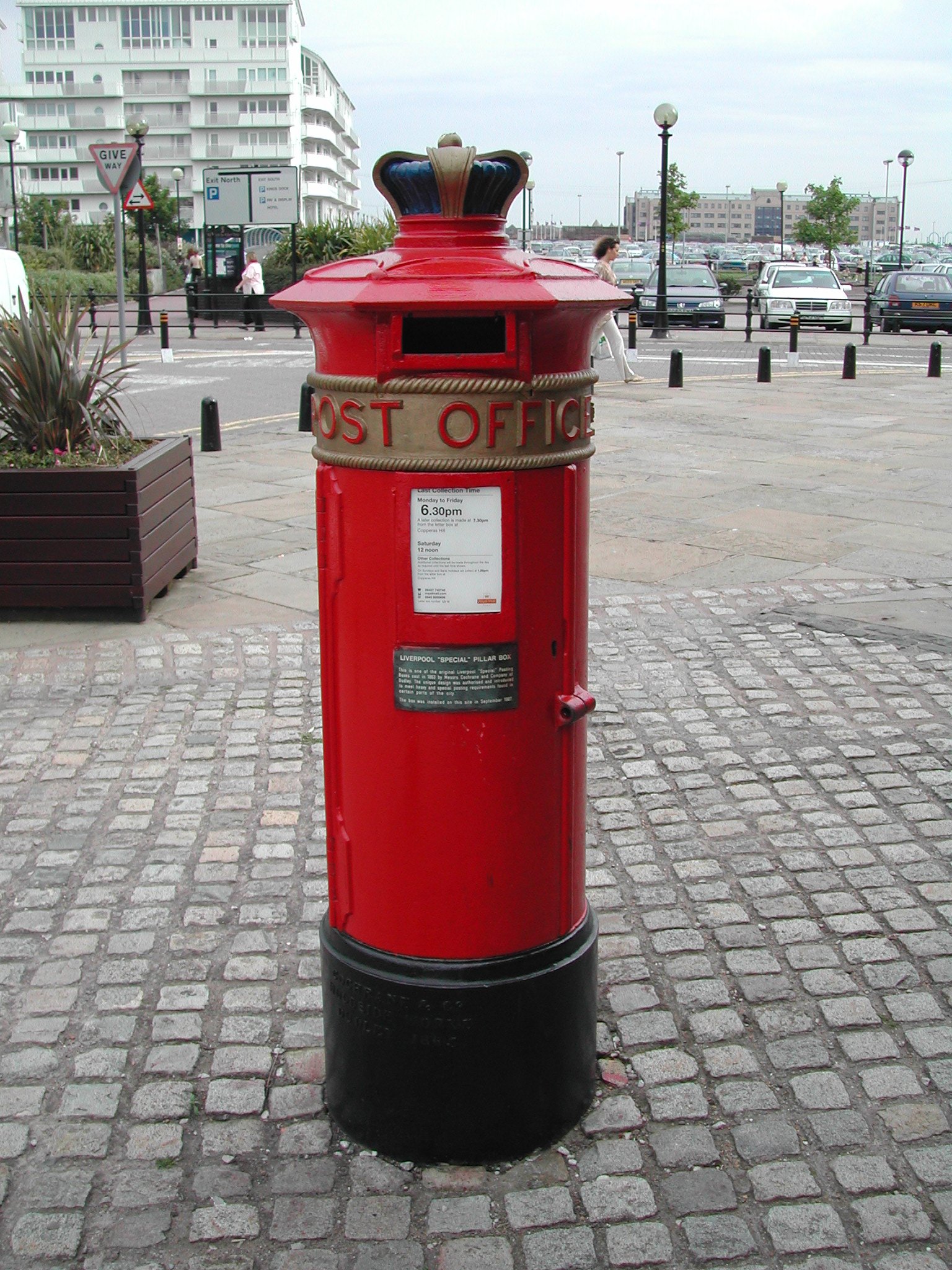
.
Perhaps the most famous of the early designs is that named after the architect who designed it, J.W.Penfold. The Penfold boxes come in three sizes and altogether there are nine different types. They are very widespread, with the biggest accumulations in London and Cheltenham. Others are spread across England, Ireland, New Zealand, India, British Guyana, Uraguay and Australia. There are no original Penfolds in Scotland or Wales, but 1989-built replicas have been erected in these areas, as well as other deserving locations where they will fit in. Many are rail-related including the NRM York, Beamish, the Black Country Museum, Crich Tramway Museum, Severn Valley Railway, Tallylyn Railway and the Bygones Museum in Basingstoke. Penfolds, distinguished by their hexagonal construction and Acanthus bud surmounting the cap, were originally exclusively city-based, but have now found there way into rural areas as well. About 300 were made, of which 150 survive. Nearly 100 replicas have also been installed, making this an ideal addition to a heritage or conservation area.
.
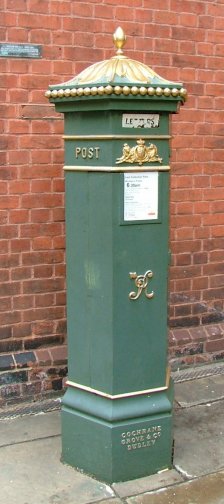
.
A return to cylindrical boxes followed with the so-called Anonymous boxes of 1879. Andrew Handyside of Derby was the foundry, but omitted the Royal Cipher and the words "Post Office" leading to the Anonymous soubriquet. It took 13 years before this error was corrected, even though the box had undergone a major design change during that time. This involved lowering the position of the aperture relative to the top of the box. The original "High Aperture" design was prone to communications becoming caught under the rim of the cap. This was solved by lowering the aperture so that it falls centrally between the two raised beading lines. Consequently the second style is known as "Low Aperture".
.
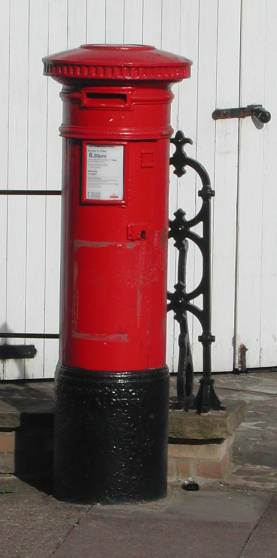 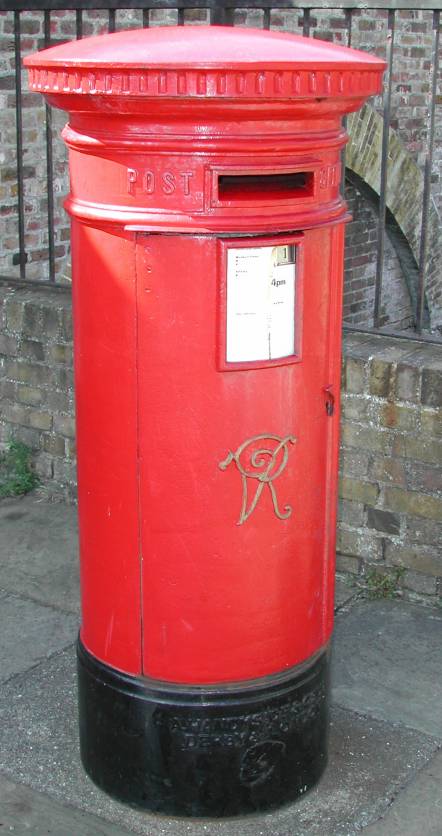
The Anonymous box (with mysterious ring on the cap) is on the left, the Jubilee pillar is on the right.
New post box designs were ordered in 1887 for Queen Victoria's Golden Jubilee. For the first time there was a lamp-post mounted letter box for use in London squares, but which soon established themselves in rural areas (see lamp boxes). For the big cities, a double aperture oval shaped pillar (designated Type C) was introduced, partly to increase capacity and certainly in London, to allow mail to be pre-sorted by region, normally with apertures marked separately for " London" and "Country". All pillar and lamp boxes now had the distinctive imperial cipher of Victoria Regina, whilst the wall-mounted boxes continued to show only a block cipher VR. The new pillar box design saw out the reign and remained little changed until 1905, when the basic design was refined.
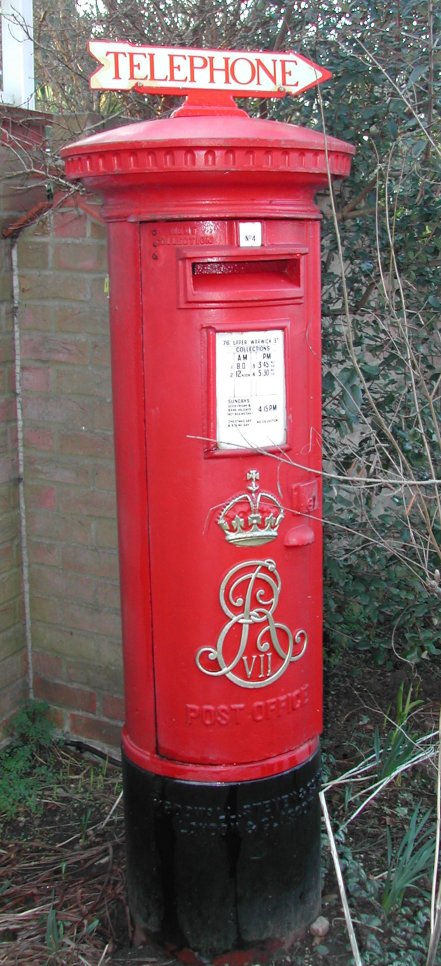
ABOVE: Edward VII box with aperture on door, post 1905, fitted with Telephone Direction Sign.
From 1905, the Edward VII boxes had the posting aperture as part of the door, rather than the body of the box. That eliminated the chance for mail to get caught up in the top of the box. This basic design remains the same today, having served well throughout the reigns of George V, Edward VIII, George VI and Elizabeth II.
An experiment of 1932 was the addition of a Stamp Vending Machine to the end of the post box. This necessitated an oval planform for the box even though it was only provided with a single posting aperture. At one end of the oval is the stamp machine and at the other is the posting aperture. The boxes have two doors; one for clearance of mail and one for emptying the cash and reloading the stamp machines. The machines were set to vend two halfpenny stamps in exchange for one old penny, the stamps being supplied in a long continuously wound roll known as a coil. Boxes were again made in two sizes, designated Type D and Type E, and carried raised lettering on the castings indicating the position of the stamp vending machine, as well as an array of small enamel plates warning users of the danger of bent coins and the need to wait for stamps to be issued before inserting more money. Several of each have survived in use in England and in the Isle of Man.
Queen Elizabeth II
The next major design change came in 1968 with the introduction of the Type F pillar box. This was conceived by Vandyke Engineering and proposed to the Post Office as a cheaper alternative to the traditional cast box. It was fabricated in sheet steel with welded construction. Unfortunately, the British climate did not suit the use of galvanised steel (a problem often seen with the 1940 and 1988 pattern of lamp box) and the Vandyke pillars soon began to rust badly. The very last one was removed from service at Colmore Row in Birmingham in 2002.
In 1974 the Post Office experimented with a similar rectangular design known as Type G. This was made in traditional cast iron by the foundry of Carron Company in Stirling, Scotland. It was an operational success, but the public disliked the "square" designs and petitioned the Post Office for a return to cylindrical boxes.
The Post Office commissioned a new design of pillar box in 1980 from a panel of three competing designers. The competition was won by Tony Gibbs and his design, which was thought to be ultra-modern at the time, was designated Type K by the Post Office. Made in traditional cast iron, it stayed in production until 2000. Notable features included: replaceable lifting ring screwed in to the dome of the box, body and roof of box cast as one piece, large easy-to-read collection time plate, all surface details and collection plate window recessed to give a perfect cylindrical outline, integral restrictor plate, know colloquially as a "Belfast Flap" to restrict posting to letters only and a flanged shallow base suitable for installation in modern buildings, shopping centres and other urban areas. These boxes were thus much easier to move and handle as they could be rolled over level ground or lifted by crane into position. The design had one major flaw in the area of the door hinge, which is prone to snap under stress and the K type pillar boxes are no longer being installed.
All new pillar boxes for use in the UK are either Type A traditional pillars or Type C double-aperture pillars from Machan Engineering in Scotland.
Scotland
In Scotland there were protests when the first boxes made in the reign of Queen Elizabeth II were produced. These bore the cipher "E II R" but Scottish nationalists objected because Queen Elizabeth is the first Queen of Scotland and of the United Kingdom to bear that name, Elizabeth I having been Queen of England only. After several pillar boxes were blown up, Royal Mail replaced them with ones which only bore the Crown of Scotland and no royal cipher. Red telephone boxes were also treated in the same way.
Ireland
Following Irish independence in 1922, existing British pillar boxes were retained, and simply painted green. Many of these are extant around the country, retaining the monogram of the monarch who reigned at the time of the box's installation. The Department of Posts and Telegraphs continued installing similar pillar boxes and wall boxes, but with the initials SE (for Saorstat Eireann), a harp or the P & T logo, instead of a monarch's monogram. Since 1984 An Post, the current Irish postal authority, use the An Post logo to adorn their posting boxes.
Bibliography
.
Old Letter Boxes by Martin Robinson. Pub. Shire Books 3rd Edn 2010
|
